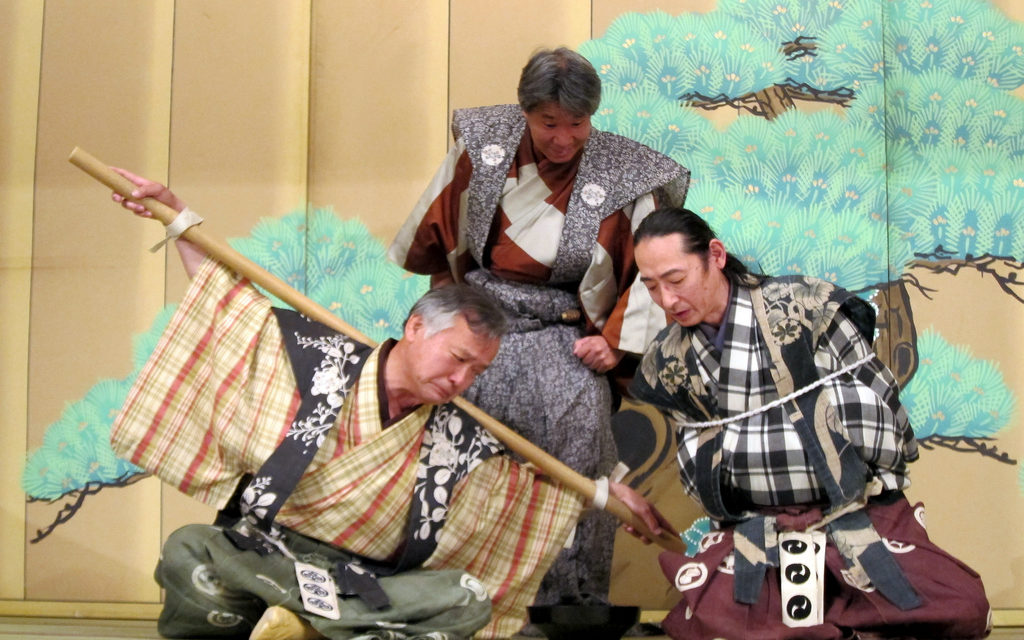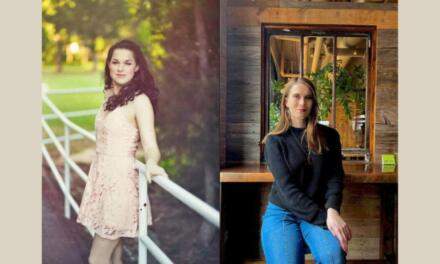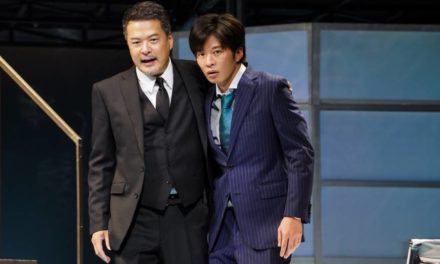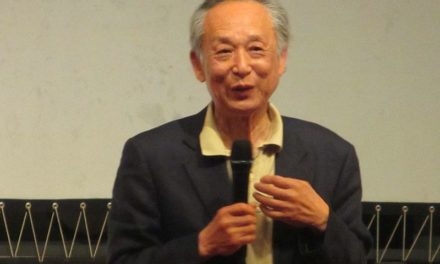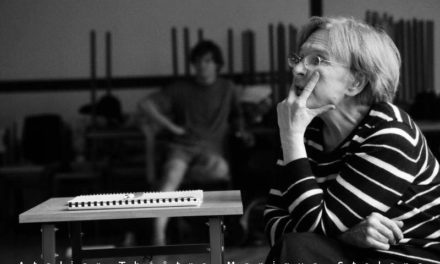Kyôgen (狂言) are short, stylized comedies performed between somber masked-dance noh (能) for over six centuries. Kyôgen had long been dismissed by scholars as noh’s silly, sometimes vulgar, younger brother. Yet since the 1930s, this stylized comic genre has been reevaluated in Japan as a uniquely powerful, quintessentially Japanese theatrical genre. Among Asian traditional forms, it is one of the few that is primarily enacted as spoken dialogue, without musical accompaniment or dance. Actors of subsequent genres–kabuki, shingeki, and experimental theater–observe and sometimes study kyôgen as a treasure house of performance techniques. In the U.S. and Japan, English kyôgen or kyôgen-like comedies are the basis for various theatre groups, including Tokyo’s Don Kenny and Shichiro Ogawa Players, San Francisco’s Theatre of Yugen, Kyoto’s the Noho Theater Group, and Prague’s Nagomi Kyogen Kai. Kyôgen has been taught regularly by Japanese masters and their foreign disciples since the 1960s at the University of Washington, the University of Kansas, Portland State University, and University of Hawaii. Professional and amateur theatre groups in Japan and overseas have demonstrated the value of kyogen’s dynamic stage presence and clarion vocalization.
I want to demonstrate the lessons of acting, plot construction, and staging which Western theater practitioners might derive from kyôgen’s potent dramaturgy. When an American amateur theater group staging Sondheim’s Pacific Overtures, a play featuring many Japanese characters and customs, asked me to provide some aesthetic basics tools of Japanese traditional theater, I began thinking about the lessons kyôgen offers the contemporary Western performer, playwright, or director. I decided to use Shibiri (Pins and Needles), the first kyôgen play I’d learned, to teach some basic principles of Japanese theater that could be applied usefully to any kind of theater.
Pins and Needles
This is one of the shortest plays in the kyôgen repertoire at just under ten minutes, often the first play taught to adult disciples. In 1984 I co-founded Traditional Theatre Training to introduce to non-Japanese scholars and artists to noh and kyôgen, taught during a six-week (later three-week) summer intensive program. When Okura school kyôgen master Shigeyama Akira chose Shibiri as the play to teach to the students on the T.T.T. program, I thought it was a mistake. Yet he assured me that its deceptively simple structure contained all the basics of kyôgen dramaturgy. Following the numbered, boldface passages in the following text permits some insight into some of those lessons.
1 “The Master and Servant enter along the hashigakari bridgeway”: who?
Even before they enter the main stage, these two stock characters are immediately recognized by cognoscenti audiences by their costumes and stance. The Master’s long-hakama, which forces him to flick his trousers in back of him as he turns, and Tarô Kaja’s broad plaid (master is stiped) kimono, are dead giveaways. As the Master reaches the nanori-za name-saying place, he stands while the Servant kneels respectfully, establishing their power relationship.
Kyôgen, like classical opera and ballet, is based on a limited repertoire–250 plays in Okura or Izumi schools combined. The dozen or so character types who appear are instantly recognizable by their costumes and headgear: yamabushi mountain wizard, Buddhist and Shinto priests, villain, servant, master, lord, demon, god, bossy or ugly woman. Kyôgen’s costumes are a shorthand method of describing the role-type and hierarchical relationships of characters to an audience able, through experience, to decode its visual texts.
2 “I live in this area”: where and why
Nanori is an opening declaration of person, place, and purpose. Whereas in noh plays, the travelling priest often identifies important locales through the nanori and the michiyuki travel song that follows, kyôgen’s anywhere, anytime mood is engendered by a placeless, nameless man. His identity is known only through his costume, stance, and demeanor, yet all are clear from his entrance along the bridgeway. When he opens his mouth, he announces, “I am a man who lives in this area,” “I am a wealthy landowner,” “I am looking for someone,” “I will call someone,” and the plot thickens.
He is speaking to the audience, not as with a Shakespearean “aside,” a revelation of inner feelings. Instead, loudly and directly, he provides the context for what is to follow. And his direct, rhythmic declarative opening sets the tone for the play as a whole, introduced clearly and boldly. In a society that famously exalts ambiguity and euphemism, this opening speech is refreshingly candid and straightforward, especially compared to the lyric, chanted noh which precedes and follows kyôgen on a typical program.
3 “I’ve learned on short notice”: infectious rhythms
This formal opening of the play is slow and deliberate, forcing attentive silence as spectators ride the pulse of the syllables. Kyôgen is known for its dynamic, loud, clear, rhythmic vocalization. This legacy of kyôgen’s historic outdoor stages is perhaps the aspect most valued by other genres in Japan today: contemporary kyôgen actors teach vocalization to bunraku puppet-theatre chanters, kabuki actors, and shingeki (modern theatre) actors. Shigeyama Sensaku IV compared the kyogen voice to that of green bamboo being sliced open: clear, powerful, and rhythmic.
These stylized vocal patterns immediately announce that kyôgen takes place in a separate world, one recognizable but removed from this one. When kyôgen performers tour junior high schools, they find that children often giggle on first hearing the resonant booming voice, belted from the stomach like a mountaineer’s “yahoo!” These resonant, rhythmic voices have a further practical purpose. Although kyôgen rarely employ masks, acting is almost always frontal, requiring perfomers to use their vocal rhythms to coordinate with each other on the wide, deep stage.
The infectious singsong rhythms follow wave-like undulations, pulsing like an undulating whip. My teacher, Shigeyama Sennojô, explained this as a series of waves, declaimed as triplets, with stress on the center of the three. These build in a larger, higher-pitched wave towards the end of a phrase, dropping off at the end. (This follows Japanese grammatical structure, where verbs often come in the phrase preceding the final tense modifier.) Each school and family has its own particular basic rhythm, but the purpose of the convention is the same: to establish a clear and pulsing singsong rhythm that seduces the audience into one’s breathing and body rhythms. These same rhythms can then be broken, as will be shown later, for effect.
4 “you came very quickly”: elastic connections
Attuned by vocal rhythms, actors move on the stage in rhythmic synchronicity, establishing a sense of unity and an elastic bond between characters on the stage. When the Master faces the audience (“it’s really nothing special”), Tarô turns forward at the same time, then returns to face the Master. If one actor steps forward in aggressive fashion, his partner counters by stepping backwards, as when the master orders Taro to “come back without delay.” This is usually followed by a reversal–Tarô stepping forward, the Master backward–to regain the original stage positions.
Even more obvious examples of these push-pull rhythms can be seen in duo mime scenes, such as the passenger bobbing in a boat with a drunken oarsman, the rider striding alongside his “horse”, or sumo wrestling. Audiences smile at the robot-like mechanistic nature of their calibrated choreography, entrained by the kyôgen world’s ineluctable attraction. Through repeated, synched movements, actors support each other, unify various stage characters through a common denominator, express their characters’ interdependent relationships with each other, while producing the comic effect of puppet-like movements, what Bergson called “the mechanical encrusted on the living.”
5 “An unexpected guest will drop by”: full frontal facing
During long speeches, actors’ face out, towards the audience. They are not, as in the name-taking scene, talking to the audience, but to each other. But if they realistically faced each other or cheated out a bit, as in Western naturalistic theater, they would be less clearly heard by the audience. Worse still, their backs would face the spectators, sitting both stage right and stage center in a traditional theatre building. These vulgar and insulting positions are avoided wherever possible. By facing front, they can also observe the audience reactions—Sennojô spoke of speaking to the back rows, while adjusting to the gaze of the front-row spectators.
The acting, however, is never entirely frontal–that would be dull, and confusing as well. Long speeches are spoken frontally, bracketed by the actors turning towards each other, usually on a diagonal. The michiyuki “traveling” is performed in a pleasant series of accelerated glides and turns that triangulate the stage, beginning and ending with frontal statements: “I’m going to . . . “ and “I’ve arrived.” Audiences easily read these stage conventions, thereby gaining the best of both worlds: they see the characters talking to each other, yet can also clearly hear the dialogue. As a practical corollary, this frontal acting allows actors to watch audiences at all times, judging their attention through observation of breathing and eye-movements. Conventions of frontal staging thus serve practical purposes, permitting actors to be heard, and audiences to be seen.
6 “I understand”: stylized kata patterns
The bow of the servant is one of many repeated kata, a precisely fixed sequence of actions that serve as the structural building blocks of any Japanese traditional performance. He places his hands flat at his side, fingers held tightly together and thumb tucked in, then slides them down along the outside of the upper thigh to just below the bending knees. The back and neck maintain perfect alignment, conveying an exaggerated icon of humble obedience.
Kata are channels of energy and meaning established over the centuries by successive generations of actors. Some performers even endow them with the force of an unchangeable magico-religious significance. They are economical and powerful, eminently readable to first-timers and pleasurable to adepts. The bow, as any kata, once established can be embellished in many ways. It can be deep or perfunctory, accompanied by a long “Yeees” or “I understand”. And the bow is a repeatable convention, taking on meaning according to shifting circumstances. Tarô bows four times in this first scene alone as a familiar punctuation to the Master’s orders, with varying degrees of resistance or shows of obedience.
The Servant here and in many kyôgen resembles the jack-in-the-box that Bergson saw as key to the comic effect: pushed down again and again until the repressed energy explodes in a dramatic and funny way. Kata are in this sense the box from which the dynamic energy for comic disruption springs. The actor uses kata, ritual-like movement and vocal patterns, to easily establish scenes and relationships which audiences take pleasure in recognizing.
7 “Well, well, what a pain”: aside to the side
The servant turns at a diagonal toward the audience, establishing the convention of an “aside.” He speaks as loudly as before, but because this is the first movement not aimed frontally within the frame of the pillars, audiences understand that they are overhearing his inner thoughts.
At the same time, the Master kneels at the back of the stage, effectively “off-stage” even while in full view on-stage (in the shadow of the temple roof on the original outdoor stages). No special lighting, curtains, doors are needed to establish that the Master has retired to an inner room while the Servant is just outside the house. Nor does the Servant need to speak in a false sotto voce to convey the fact that he is alone, speaking to himself.
Kyôgen actors must create their world through their actions and words. The characters reveal motivations or back-stories, which might be unveiled more gradually and by innuendo in everyday life or more realistic genres. The dialogue provides sufficient clues for audiences to understand the general situation, a device Sennojô quips is a kind of “self-service” (in Japanese, serifu=dialogue). By breaking from previous conventions of frontal declamation, the actor creates a new dramatic focus, while spotlighting these words.
8 “I’ve got to think quickly”: theme and variation
Once established, kata can be altered for effects of humor, surprise, and pacing. And so, the same sinking bowing pose of the first scene is coupled with a slight turn of the head as one gazes sideways and down (“I’ve got to think quickly. What shall I do?”) Voila! A bow becomes a ponder. The eavesdropping pose is another variant of the bow: legs further apart, head tilted to place the ear closer to what?.
The Master never bows, but he does sink/think later in the play, only his is less exaggerated: knees barely bending, head cocked slightly rather than angled sharply to the side. In other plays, laughing and crying are variants on the bow, with “haaa” or “heee” as accompanying sound. By performing such variations on a theme, actors create a stage unity that would be challenging with more detailed or individualized pantomime. Kata are conventionalized variants on a few codified movements. These fixed sequences are performed by all, but “worn with a difference” by diverse characters to distinguish their statuses, inter-relationships, and moods.
9 “Oh, ow, Ouch!”: repetition and rupture
Kyôgen’s smooth, rhythmic patterning is ruptured to tremendous effect. Here the servant stretches his arms out wide, stamps, and shouts, “Ouch!” breaking the smooth horizontal line of prior movements with a vertical stamp and “collapse.” The arrhythmic bellow of pain coupled with the sudden and uncharacteristic stamp and fall immediately gains the attention of the spectators and Master, who quickly rises from the back of the stage in response.
Repetition and ruptures of the rhythmic patterns produce similar effects. Later, Tarô orders his cramps to disappear with the same patronizing tone that the Master uses when ordering him to the store. When the master orders Tarô to command his leg cramps to heal, Tarô rubs them, ordering, “Eei–hoi!” The last syllable is usually flung to the side with an off-beat falsetto, disrupting both the rhythm and melody, gaining immediate laughter. Tarô then explains, “That was the sound of the cramps agreeing to go away.” Patterns and their variations, once established, can be ruptured to great effect.
10 “This magic cure”: flexible props
The Master reverses the fan he holds in his right hand, kneeling to twist some “dirt” onto his thumb with the fan hilt. Fans are effortlessly transformed through their practical use in kyôgen, becoming words, pipes, doors, saws, sake bowls, and flasks. They are taken out, opened, half-opened, or closed appropriately, then returned to sashes when their usefulness is over. A kazuraoke wig-box becomes in kyôgen a stool, barrel, horse, or, when stood upon, a tree. Kyôgen plays employ a minimum of properties, which, like gestural kata, can be employed with variations in multiple ways.
This simplified palate allows a wide range of meanings to accrue to a limited number of mimetic movements. Eating persimmons, chestnuts, or mochi rice-cakes are exactly the same: the cupped hand is swiped over the mouth at a diagonal, as the actors make munching sounds, “anm, anm, anm.” The only distinction about eating molasses is that a fan hilt is used as a spoon. The minimal properties are used to maximal effect on the bare kyôgen stage. As kyogen are traditionally performed as entra’actes between noh plays which might employ elaborate set properties (hut, well, bell, boat), the minimal properties allow for speedy entrances and tidy exits.
11 “Please listen carefully”: katari narratives
Katari are speeches about the past, chanted narratives found in many traditional performance genres. In the play, the preceding line, “I am listening,” is slow and rhythmic, presaging the dignified delivery of the following speech. This is mock-heroic, as Tarô Kaja is offering as family tragedy the fact that he inherited the family cramps. It is nonetheless spoken in a highly dignified manner with sharp cadences. The kyôgen storyteller is also an essential part of a noh play proper, where he often appears as an ai-kyogen between acts to tell a back- story or related tales (while the noh actor changes costume and mask). Inserted in a kyôgen play, the katari provide a parody of the origin-myths found in noh katari, a serious episode before the frenetic comic denouement.
12 “(Tarô rises, and sneaks up)”: split-screen cinematography
Here two scenes–the Master pretending to be called out to a party, and Tarô sneaking up to hear the conversation–occur simultaneously. As Tarô “awakes” from where he’s been waiting at the name-saying (is what you have above) place, he creeps forward, with a high-stepping, crab-like sneaky creep (shinobi ashi) at the same time that the Master is engaged in conversation with the (invisible) “uncle’s servant.” Viewers have to decide which character to observe, then follow them as the distance between them decreases, then increases swiftly as Tarô scurries back to the name-taking place.
Kyôgen has been called a cinematographic art, in which the actor’s body determines the audience’s point-of-view, like a camera; here the audience is forced to view the actors in a split shot then a pan to a wide shot. The effect can be confusing, but also thrilling, when the two stories–Master talking, Servant eavesdropping–come together with the Master’s farewell and Servant’s overlapping imploring, “Hey, take me with you!” In other plays, two characters speak simultaneously, and often with conflicting narratives, from different positions on the stage. Spectators enjoy making sense of these simultaneous speeches, especially when they are prelude to a predictable collision. Such simultaneous, “split-screen” action is one of kyôgen’s many dramatically potent expressions.
13 “Hey, pins and needles!”: reversal of fortunes
Echoing earlier orders by Master, Servant now orders his cramps to go away. This reversal of fortune can be found in many kyôgen[9]: a child throws his father down (Iroha); a divorced wife bags her husband (Enmei bukuro); a servant is ashamed of his boorish master (Hagi daimyo), a passerby disarms and disrobes two arrogant Lords (Futari Daimyo), a monkey brings a powerful lord down to his level (Utsubozaru). Spectators can enjoy the breaking of taboos and the overturning of socio-political hierarchies, knowing it is only temporary: the rules of order will reassert themselves, sometimes with a vengeance.
And indeed, a further reversal now occurs, and here the play ends, with the total humiliation of the clever Tarô, who only temporarily seemed to have the upper hand (leg?). He has been exposed via this ruse as a lazy liar. The jack-in-the-box is pushed down forcefully into the box once more. In this unusual “shikaridome” (scolding ending), actors end the play on stage, with Tarô’s deep bow. There is no curtain, lighting cue, or even verbal cue, to indicate this, only the finality of the actor’s voices. As the actors depart (and in other plays, stage assistant picks up the few properties), the stage is clear again, ready for the noh that follows, the spectators’ palates cleansed.
This post was written by the author in their personal capacity.The opinions expressed in this article are the author’s own and do not reflect the view of The Theatre Times, their staff or collaborators.
This post was written by Jonah Salz.
The views expressed here belong to the author and do not necessarily reflect our views and opinions.

